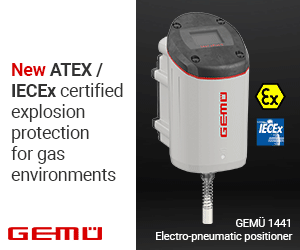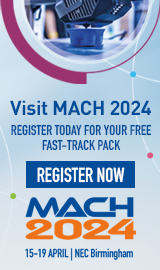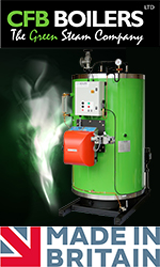FOOD SAFETY GETS SMARTER
Driven by ever-stricter safety regulations and the need for traceability across the supply chain, food manufacturers are increasingly turning to inspection solutions with improved precision and greater digital capabilities. Metal detection specialist Fortress Technology examines the different factors that are accelerating the need for smarter systems, and how intelligent inspection equipment is helping to usher in a new era of food safety.
Beyond identifying contaminants, smarter technology is being used within or alongside inspection systems to improve efficiency, compliance and, ultimately, profitability. As consumer trends, production methods and delivery platforms continue to shift at a rapid pace, the U.S. Food and Drug Administration (FDA) has addressed these changes with its New Era of Smarter Food Safety.
Building on the framework of the FDA Food Safety Modernization Act (FSMA), as with many developments in food safety, other countries, including the UK, are expected to converge towards this blueprint and the application of technology-enabled traceability to trace a contaminated food to its source. Additionally, the FDA’s blueprint outlines the need for smarter tools and approaches for prevention and outbreak responses, new business models, retail modernisation and ways to embed a food safety culture throughout the supply chain.
Although the 10-year plan was initially set for release in spring 2020, it had to be delayed until July due to the coronavirus. However, the ongoing pandemic and the challenges it has presented to food suppliers has fast-tracked the need for more advanced inspection equipment with greater connectivity and data capture capabilities.
Digital testing for greater traceability
As new food legislation suggests, traceability is, and will continue to be, a key priority. The speed at which a food company can publicly pinpoint the source of a contaminant is imperative and can minimise the damage caused by a recall. While inspection systems such as metal detectors and x-ray are an integral first step in quality control, proper management with regular testing is vital to ensure optimum protection is achieved.
In its blueprint, the FDA discusses the feasibility of remote, virtual, and/or component inspections of foreign and domestic firms. This principle can also be applied to the testing process of metal detectors and x-ray machinery. Automatic digital testing software, for example, is starting to gain industry acceptance. This technology is designed to complement manual processes, allowing for tests and records to be activated automatically and even remotely if required.
Leveraging digital concepts for this critical step in food safety compliance provides manufacturers with a true measure of how each inspection machine is performing. Testing interoperability not only removes the risk of human error, but also reduces labour costs and safety hazards associated with manual checks, in addition to providing a reliable audit trail for traceability purposes.
From paper fail to digital trail
The next step in the new phase of food safety involves the elevation of systems that currently run on paper. As is shown by the recent spate in food recalls, paper-based record keeping is a chink in the progress of track-and-trace efforts. It also hinders traceability required to better understand and respond to the increasingly complex supply chain in the event of unprecedented circumstances such as the COVID-19 pandemic.
Digital tools with paperless audit software and data capture are helping to address these issues, allowing manufacturers and retailers to remove potentially unsafe products from the market more quickly and review the root cause for preventative measures. When moving forward with a track-and-trace initiative, food suppliers should seek inspection machinery specialists that can work alongside them to facilitate data collection and electronic reporting.
Advanced new systems with data collection and paperless test routines will become more prevalent moving forward. For example, manufacturers might opt for a combination metal detector and checkweigher capable of pre-configuring every test by retailer code of practice and product being inspected. As demonstrated by the Raptor series recently launched by Fortress, integrated sensors can confirm when a check has been conducted, generating a dated digital due diligence report that is signed by the operative on the screen for full transparency.
Built-in data capture with remote access means QA managers can troubleshoot and generate reports from their phone, laptop, or tablet, with the test parameters and machinery functionality all in one place. This is just one case that illustrates the future of food safety management, and where the availability of digital tools is helping to improve visibility and efficiency across the board.
The future of metal detection technology
To fully realise this prevention-based framework, consideration must be given to make processes more effective and efficient. As much as food manufacturers must adopt inspection equipment with improved sensitivity levels, an equally important criterion is to eliminate false rejects.
Identifying metal within conductive products can involve changing the frequency to minimise the effect. However, this can have a devastating impact on the accuracy of a detector, as operators might lower the sensitivity to the point where contaminants pass through.
To overcome this issue, some food firms are turning to advanced systems that offer multi-orientation, multi-scan detection. Compared to the traditional single or dual frequency food metal detectors, this new methodology uses multiple coil sets to instantaneously drive the electromagnetic fields in different directions. Rather than missing a metal contaminant because it hasn’t aligned with a specific field, it looks for signals over a broad spectrum, from various angles. The stronger disturbance from one field compensates for the weaker signal from another. In essence, it’s like running numerous systems all at once.
Critically, this newest approach to metal detection addresses several previous limitations. Notably, orientation, size, geometry, and position of metals, and even in products with a low side profile. Alongside eliminating the risk of false rejects and ensuring high sensitivity, in-built automatic product tracking and data capture software will further increase transparency and traceability.
X-ray or metal detection: Why there’s room for both
The most common contaminant remains metal, for example fragments that break off during mechanical cutting and blending operations. However, glass from storage or packaging, hard plastics introduced by fatigued tools and equipment, and animal bones or other parts are all potential safety hazards, making x-ray an important tool on many food manufacturing lines today.
When it comes to adopting smarter technologies and approaches, it is not wise to pit metal detection and x-ray against one another. Depending on the application, both have a place on a production line. Metal detectors are integral to identifying low-density metals, while x-ray machines are worth investing in if there is a contamination risk of other foreign materials.
Factory layouts and the placement of inspection machinery is another important consideration. When working together, an x-ray system will tend to favour an in-line position, whereas metal detectors are better located towards the end of the processing line, often after packaging.
Fortress Technology’s commercial manager Jodie Curry concludes: “While an x-ray machine will be able to detect things a metal detector can’t and vice-versa, ultimately both are complementary technologies. The same can be said for advanced inspection systems and well-executed food safety programs. Smart technology must be implemented alongside more effective and modern approaches to preventative measures and safety strategies. As the supply chain grows increasingly complex and we enter this next era of technological developments, it essential to work closely with a solution provider who can help you to maximise the benefits of your equipment and keep pace with an ever-changing industry.”

Some food firms are turning to advanced systems that offer multi-orientation, multi-scan detection

Digital test technology can be fitted to bulk, gravity, pipeline, and conveyor style metal detectors

For maximum efficiency, manufacturers can now opt for a system that pre-configures every test by retailer code of practice and product being inspected



























































































































